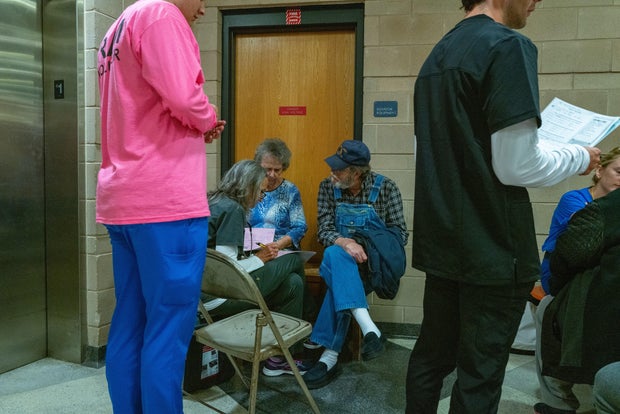
During Matthew Roach’s two years as a vital statistics manager for the Arizona Department of Health Services, and 10 years before that in its epidemiology program, he witnessed a trend in mortality rates which has rural health experts are worried.
As Roach monitored the health of Arizona residents, the gap between the death rates of people living in rural areas and those of their urban peers widened.
Health disparities between rural and urban Americans have long been documented, but a recent report from the Department of Agriculture’s Economic Research Service found that the chasm has widened in recent decades. In their study, USDA researchers found that rural Americans ages 25 to 54 die from natural causes, such as chronic disease and cancer, at much higher rates than those in the same age group living in urban areas. The analysis did not include external causes of death, such as suicide or accidental overdose.
The research analyzed death data from the Centers for Disease Control and Prevention over two three-year periods: 1999 to 2001 and 2017 to 2019. In 1999, the natural cause death rate for people ages 25 to 54 years in rural areas was only 6% higher than that of people aged 25 to 54. for city dwellers of the same age group. In 2019, the gap widened to 43%.
Researchers found that this growing gap was driven by rapid growth in the number of women living in rural areas who are dying young from treatable or preventable illnesses. In the most rural areas, that is, counties without an urban core of 10,000 or more people, women in this age group saw their natural cause mortality rates increase by 18% over the the study period, while their male peers experienced a 3% increase.
Within the working age group, cancer and heart disease were the leading natural causes of death for both men and women, in both rural and urban areas. Among women, the incidence of lung diseases in remote parts of the country has increased the most compared to rates in urban areas, followed by hepatitis. Pregnancy-related deaths also played a role, explaining the highest growth rate of natural mortality among women aged 25 to 54 in rural areas.
Negative trends among rural non-Hispanic American Indians and Alaska Natives were particularly pronounced. The analysis shows that Native Americans ages 25 to 54 experienced a 46 percent increase in the natural-cause death rate over those two decades. Native women experienced an even larger increase in mortality rate, 55 percent, between the two periods studied, while the rate for non-Hispanic white women increased 23 percent.
The rural-urban gap widened in all regions of the country, but was more pronounced in the South.
/Getty Images
The increase mortality rates are an indicator of deteriorating population health, the study authors note, which can harm local economies and employment.
As access to and quality of health services in rural areas continues to erode, rural health experts said, the USDA’s findings should spur stronger policies focused on rural health.
Alan Morgan, CEO of the National Rural Health Association, said he found the report “shocking” but “unfortunately, not surprising.”
The disparity deserves greater attention from state and national leaders, Morgan said.
The study does not address the causes of increased mortality rates, but the authors note that differences in health care resources could compromise access, quality and affordability of care in rural areas . Hospitals in small, remote communities have long struggled, and continued closures or conversions limit health care services in many places. The authors note that consistently higher rates of poverty, disability and chronic disease in rural areas, compounded by fewer doctors per capita and hospital closures, affect community health.
Roach said his former job as an epidemiologist involved working with social vulnerability indices, which take into account income, race, education and access to resources like housing to get a sense of the resilience of a community in the face of health problems. A map of Arizona shows that rural counties and reservations have some of the highest vulnerability rankings.
Janice C. Probst, a retired University of South Carolina professor whose work focused on rural health, said many current rural health efforts focus on maintaining hospitals, which, according to her, are essential sources of health care. But she added that may not be the best way to address inequality.
“We may need to take a community approach,” said Probst, who reviewed the report before its release. “Not how can we keep the hospital in the community, but how can we keep the community alive?
Demographic disparities stood out to Probst, among other things. She said states with the highest natural death rates in rural areas included South Carolina, Mississippi, Georgia, Alabama and others that have not expanded Medicaid, the joint federal and state health insurance program for low-income people, although there are efforts to expand it in some states, particularly Mississippi.
This is also an observation made by USDA researchers.
“At the regional level, differences in states’ implementation of Medicaid expansion under the Affordable Care Act of 2010 could have increased implications for uninsured rural residents in states without expansion in potentially influencing the frequency of medical care for those at risk,” they wrote.
Wesley James, founding executive director of the University of Memphis Center for Community Research and Evaluation, said state lawmakers could solve part of the problem by advocating for Medicaid expansion in their states, which would increase access to health care in rural areas. A large group of people want it, but politicians don’t listen to their needs, he said. James also reviewed the report before its release.
According to a KFF poll, two-thirds of people living in non-expansion states want their state to expand the health insurance program.
Morgan added that the study focused on deaths that occurred before the COVID-19 pandemic, which had a devastating effect in rural areas.
“COVID has really changed the nature of public health in rural America,” he said. “I hope this will prompt Congress to direct the CDC to examine rural-urban relationships. life expectancy during COVID and since COVID to get a sense of what we’re actually seeing nationally.
In Arizona, the leading cause of death among people ages 45 to 64 in 2021, in both rural and urban areas, was COVID, according to Roach.
KFF Health News is a national newsroom that produces in-depth journalism on health issues and is one of the major operating programs of KFF — the independent source for health policy research, polling and journalism.
Grub5






